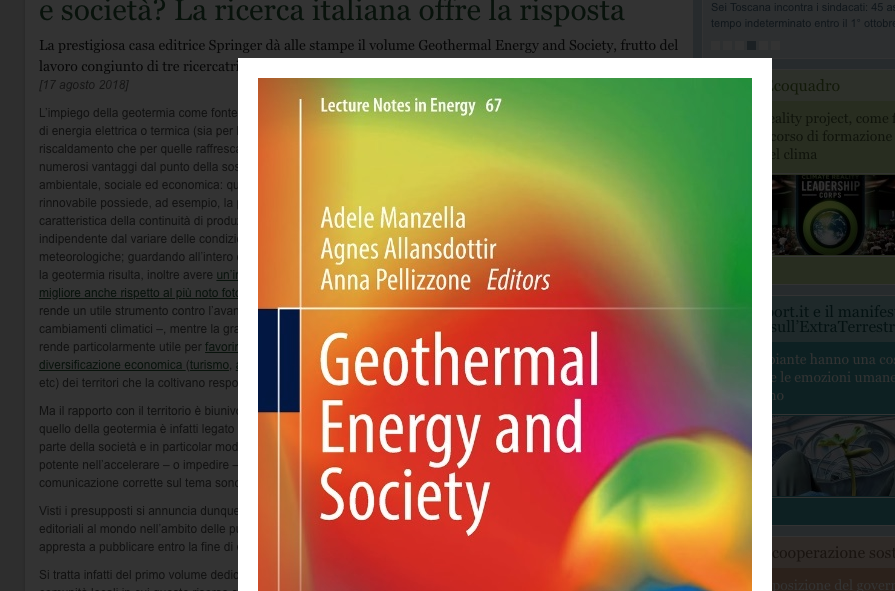Exploring the relationship between geothermal energy and society
Scientific publisher Springer has released an interesting book on the impact of geothermal energy utilisation to society publishing research by three Italian researchers.
What do we know about the relationship between geothermal and society? A group of Italian researchers share their findings in a new book published by Springer publishing house. The Book “Geothermal Energy and Society”, is the result of the joint work of three researchers: Adele Manzella, Agnes Allansdottir and Anna Pellizzone
The use of geothermal energy as a source for electricity or heat production (both for heating and cooling) shows numerous advantages from the point of environmental, social and economic sustainability: this renewable source has, for example, the precious characteristic of being a baseload capacity with continuous energy production. Furthermore it is independent weather conditions. Looking at the entire production cycle, geothermal energy also has a better carbon intensity than the best known solar photovoltaic – making it a useful tool against the advance of climate change – while its versatility makes it particularly useful for promoting economic diversification (tourism, agri-food, etc.) of the areas that cultivate it responsibly.
But the relationship with its surroundings is unequivocal: as for any other development in the industrial and in particular energy sectors, that of geothermal energy is in fact deeply linked to social dialogue. The acceptance of geothermal technologies by developers and in particular the territories that see the direct presence of the plants play an active and powerful role in accelerating – or preventing – the sustainable development of this renewable energy source. This is why information and correct communication on the topic are essential elements for both politics and for citizens to evaluate and decide.
In this context the new book published by Springer should be of interest: Geothermal Energy and Society .
It is in fact the first book dedicated to exploring the different aspects of the relationship that binds geothermal resources to the local communities in which these resources are present and cultivated, both for the production of electricity and thermal, clarifying information available so far only in a fragmented way in the scientific literature. The work presented in the book should though be of particular interest in the Italian context. Although addressing the issue in a global perspective – it is the result of the joint work of three authors who work daily in Italy: Adele Manzella (first researcher at the Institute of Geosciences and Geology), Agnes Allansdottir (University of Siena) and Anna Pellizzone (PhD Scholarship), who have dedicated over the years more research work (for example: Italian Geothermal Association).
The Geothermal Energy and Society book offers the opportunity to take stock of what we know about the topic: the first section is dedicated to introducing geothermal energy together with related sector policies and social aspects, while the second presents a selection of 11 case studies addressed with scientific rigor; a final chapter is finally dedicated to ordering what has been learned.
“In the course of my activity, I realized how little is known about geothermal in general”, said Adele Manzella, while underlining the need to expand the relationship between research and society to help citizens to understand geothermal, and therefore to relate in an informed way with this renewable source and its possible developments in the area. Geothermal Energy and Society offers a useful “toolbox” to set up a work of this kind, whose need is increasingly felt.
The book is available via Springer
Source: GreenReport


















